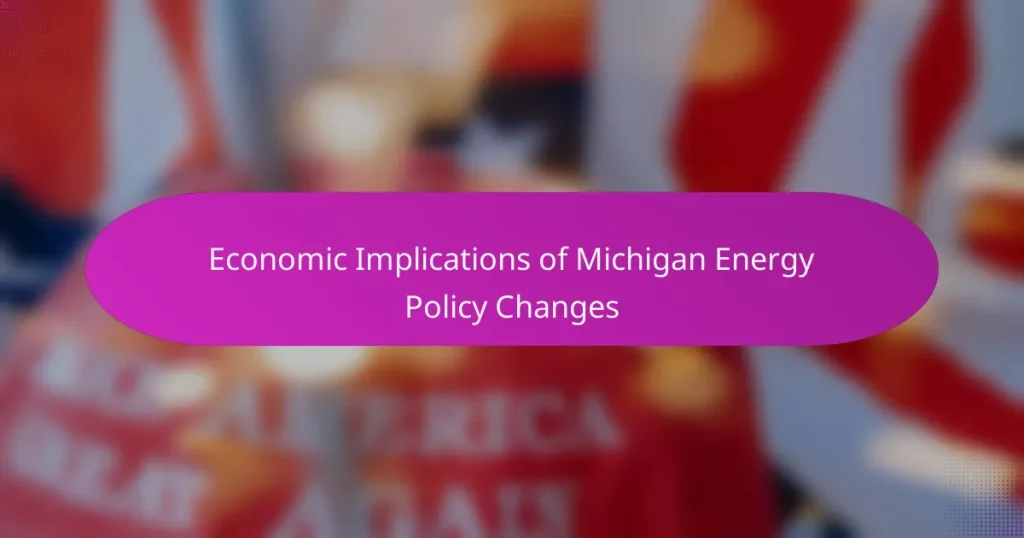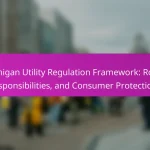
What are the Economic Implications of Michigan Energy Policy Changes?
Michigan energy policy changes can significantly impact the state’s economy. These changes may lead to job creation in renewable energy sectors. For instance, investments in solar and wind energy can generate thousands of new jobs. Additionally, energy policy shifts can influence energy prices for consumers and businesses. Lower energy costs can enhance competitiveness for local industries. Conversely, regulatory changes may impose costs on traditional energy sectors, affecting employment in those areas. Transitioning to cleaner energy sources can also attract federal funding and incentives. This funding can stimulate local economies and infrastructure development. Overall, the economic implications of Michigan’s energy policy changes encompass job creation, energy costs, and investment opportunities.
How do Michigan’s energy policy changes impact local economies?
Michigan’s energy policy changes positively impact local economies by promoting renewable energy development. These policies encourage investment in solar and wind energy projects. Increased investment leads to job creation in the renewable energy sector. According to the Michigan Energy Innovation Business Council, the clean energy sector employs over 100,000 people statewide. Additionally, local businesses benefit from increased demand for energy-efficient technologies. Energy savings from these policies also reduce costs for consumers and businesses. This boosts disposable income and stimulates local spending. Overall, Michigan’s energy policy changes drive economic growth and enhance community resilience.
What sectors are most affected by these policy changes?
The sectors most affected by these policy changes include energy, manufacturing, and transportation. The energy sector faces significant adjustments due to new regulations promoting renewable sources. Manufacturing may experience increased costs related to energy efficiency mandates. Transportation is impacted by shifts in fuel standards and infrastructure investments. These changes aim to reduce carbon emissions and promote sustainability. Historical data shows that similar policies in other states led to job shifts in these sectors. For example, California’s energy policies resulted in increased employment in renewable energy jobs.
How do these changes influence job creation in Michigan?
Changes in Michigan’s energy policy positively influence job creation. The transition to renewable energy sources leads to the development of new industries. These industries require a skilled workforce, prompting job growth in sectors like solar and wind energy. For example, the Michigan Energy Innovation Business Council reported a 20% increase in clean energy jobs from 2019 to 2021. Additionally, investments in energy efficiency programs create construction and manufacturing jobs. As companies expand their operations to meet new regulations, they also hire more employees. Overall, these policy changes foster a robust job market in Michigan’s energy sector.
What are the potential benefits of the new energy policies?
The potential benefits of the new energy policies include increased energy efficiency, reduced greenhouse gas emissions, and enhanced energy security. These policies aim to promote renewable energy sources, such as wind and solar. By transitioning to cleaner energy, Michigan can lower its carbon footprint. Studies show that renewable energy can create jobs in manufacturing and installation. Additionally, energy efficiency measures can lead to lower utility bills for consumers. Enhanced energy security reduces reliance on fossil fuel imports. Overall, these policies support economic growth while addressing environmental concerns.
How might these policies lead to cost savings for consumers?
These policies might lead to cost savings for consumers by promoting energy efficiency and renewable energy sources. Energy efficiency programs can lower utility bills by reducing overall energy consumption. For example, a study by the American Council for an Energy-Efficient Economy found that households participating in energy efficiency programs saved an average of $200 annually. Additionally, increased use of renewable energy can stabilize energy prices. According to the U.S. Energy Information Administration, renewable energy costs have decreased by 70% since 2009. This trend can further reduce reliance on fossil fuels, which are subject to market volatility. Overall, these policies encourage sustainable practices that can lead to long-term financial benefits for consumers.
What environmental benefits can be expected from these changes?
The environmental benefits expected from Michigan’s energy policy changes include reduced greenhouse gas emissions and improved air quality. Transitioning to renewable energy sources can decrease reliance on fossil fuels. This shift can lead to a significant reduction in carbon dioxide emissions, which are a major contributor to climate change. Additionally, cleaner energy options can minimize air pollutants that cause respiratory issues. According to the Michigan Department of Environment, Great Lakes, and Energy, renewable energy can reduce emissions by 50% by 2030. Enhanced energy efficiency measures also contribute to lower energy consumption, further benefiting the environment. These changes promote biodiversity by reducing habitat destruction associated with fossil fuel extraction. Overall, the policy changes contribute to a healthier ecosystem and a more sustainable future.
What challenges do Michigan’s energy policy changes present?
Michigan’s energy policy changes present significant challenges, including increased costs for consumers and businesses. Transitioning to renewable energy sources may require substantial investments in infrastructure. This transition can lead to higher utility rates during the adjustment period. Additionally, there are regulatory hurdles that can slow down the implementation of new energy initiatives. Job displacement in traditional energy sectors is another concern, as workers may need retraining for new roles in renewable energy. Furthermore, ensuring energy reliability while integrating diverse energy sources poses technical challenges. These factors collectively complicate the state’s energy transition efforts.
What are the financial risks associated with transitioning energy sources?
The financial risks associated with transitioning energy sources include high capital costs, regulatory uncertainties, and market volatility. High capital costs arise from the need for investment in new infrastructure and technology. For instance, renewable energy projects often require significant upfront funding. Regulatory uncertainties can lead to unexpected changes in policy, affecting profitability. Market volatility can result from fluctuating energy prices, impacting revenue stability. According to a report by the International Energy Agency, investments in renewable energy reached $280 billion in 2020, highlighting the substantial financial commitment required. Additionally, the risk of stranded assets exists if fossil fuel investments become obsolete. These factors collectively contribute to the financial risks of transitioning energy sources.
How might these policies affect energy prices in the short and long term?
These policies may increase energy prices in the short term due to implementation costs. Utilities often pass these costs onto consumers. For instance, investments in renewable energy infrastructure can lead to higher initial rates. In the long term, energy prices might stabilize or decrease. This can occur as renewable energy sources become more efficient and cheaper. Historical data shows that states investing in renewables often see price reductions over time. For example, California’s commitment to renewables has led to lower prices compared to fossil fuel dependency. Thus, while short-term increases are likely, long-term benefits may offset initial costs.
How do stakeholders perceive the economic implications?
Stakeholders perceive the economic implications of Michigan energy policy changes as significant and multifaceted. They recognize potential benefits such as job creation in renewable energy sectors. A report by the Michigan Energy Innovation Business Council highlights that transitioning to clean energy could create over 60,000 jobs by 2030. Stakeholders also express concerns about increased energy costs for consumers. According to the Michigan Public Service Commission, residential energy rates could rise by up to 15% due to policy adjustments. Additionally, businesses worry about the competitiveness of energy prices in attracting investments. Overall, stakeholders view these changes as a balance between economic growth and cost management.
What are the views of local businesses on energy policy changes?
Local businesses generally express concern regarding energy policy changes. They often cite rising costs as a primary issue. Increased energy prices can impact operational expenses significantly. Many businesses advocate for policies promoting renewable energy sources. They believe such policies can lead to long-term savings and sustainability. Additionally, local businesses seek clarity in regulations to plan effectively. Uncertainty can hinder investment and growth. Surveys indicate that a majority favor incentives for energy efficiency improvements. This aligns with their goal of reducing overhead costs while supporting environmental initiatives.
How do policymakers balance economic growth with environmental concerns?
Policymakers balance economic growth with environmental concerns by implementing sustainable development strategies. These strategies aim to promote economic activities that do not harm the environment. For example, they may invest in renewable energy sources, which create jobs while reducing carbon emissions. Additionally, regulations can be established to limit pollution and encourage eco-friendly practices. Research shows that states adopting green policies often experience economic benefits, such as increased energy efficiency and innovation. In Michigan, energy policy changes have led to both economic growth and improved environmental outcomes, demonstrating this balance.
What strategies can be employed to maximize economic benefits?
Implementing renewable energy sources is a key strategy to maximize economic benefits. Transitioning to solar and wind energy can create jobs in manufacturing, installation, and maintenance. According to the U.S. Department of Energy, the solar industry alone employs over 250,000 workers. Investing in energy efficiency programs reduces costs for consumers and businesses, leading to increased disposable income. Policies that encourage energy innovation can stimulate local economies and attract investments. Additionally, leveraging federal tax incentives can enhance financial returns on energy projects. Engaging communities in energy planning ensures that local needs are met, fostering economic resilience. Lastly, promoting energy storage technologies can enhance grid reliability and create new market opportunities.
How can community engagement enhance the effectiveness of new policies?
Community engagement can enhance the effectiveness of new policies by fostering collaboration and building trust. Engaged communities are more likely to understand policy objectives. This understanding leads to better compliance and support. Additionally, community input can identify practical challenges and opportunities. For instance, feedback from local stakeholders can shape policies that are more relevant and effective. Research shows that policies developed with community input have higher success rates. A study by the National Civic League found that community engagement improves policy outcomes by up to 30%. Thus, involving the community is essential for the successful implementation of new policies.
What best practices should be adopted for successful implementation?
Successful implementation of Michigan energy policy changes requires stakeholder engagement and clear communication. Engaging stakeholders ensures that diverse perspectives are considered. This can lead to more comprehensive and effective policies. Clear communication keeps all parties informed about changes and expectations. It helps in building trust and reducing resistance. Regular monitoring and evaluation are essential to assess the impact of the policies. This allows for timely adjustments based on performance data. Additionally, providing training and resources supports stakeholders in adapting to new policies. Implementing these best practices can enhance the effectiveness and acceptance of energy policy changes in Michigan.
The main entity of the article is Michigan’s energy policy changes and their economic implications. The article examines how these policy shifts can lead to job creation in renewable energy sectors, influence energy prices for consumers and businesses, and attract federal funding for local economies. It highlights the positive impacts on local economies, the sectors most affected, potential benefits such as energy efficiency and reduced emissions, and the challenges associated with transitioning to renewable energy sources. Additionally, it addresses stakeholder perceptions and the importance of community engagement and best practices for successful implementation of these policies.


